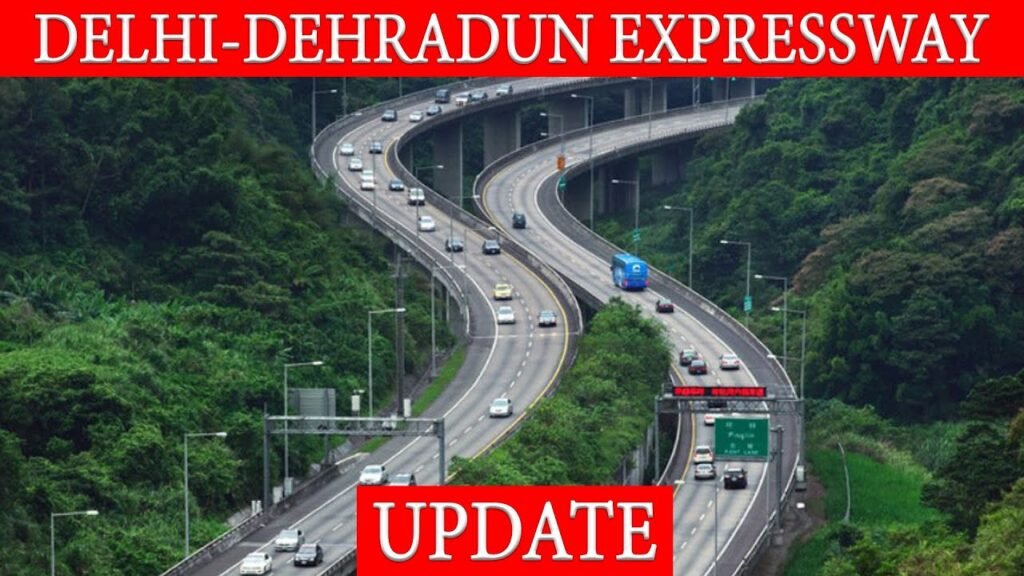Delhi-Dehradun Expressway 24 Pillars Weakened by Floods

The Delhi–Dehradun Expressway one of India’s largest and most ambitious highway projects was billed as a game-changer a high-speed, access controlled corridor cutting travel time between the national capital and the Doon valley, carrying engineering highlights such as long elevated stretches and Asia’s longest wildlife corridor. But heavy monsoon rains and aggressive flood flows have recently exposed a vulnerability in the expressway’s elevated sections: engineers identified weaknesses in 24 pillars located on or near riverbeds, and a program of reinforcement (jacketing and related measures) is now underway. This episode has opened a debate that brings together engineering practice, environmental reality, project governance and the question of how to build resilient infrastructure in a changing climate.
This long-form article examines the issue in depth: what exactly happened, why pillars weakened, how authorities are responding technically, the safety and governance implications, broader lessons for climate-resilient infrastructure and what users and policymakers should notice going forward.
Project context: what the Delhi–Dehradun Expressway is and why it matters
The Delhi-Dehradun Expressway is a transformative roadway project planned to run roughly 210-213 km between Delhi and Dehradun. Designed as an access-controlled, high-speed corridor it includes long elevated sections, an extensive wildlife passage near Rajaji National Park, multiple tunnels and underpasses, and ancillary links toward Haridwar. The project carries a huge budget and strategic importance both for connectivity and for tourism, pilgrimage and regional development with central government releases placing the project cost in the ballpark of ₹11,000-12,000 crore.
Because the alignment cuts across diverse terrain from the plains outside Delhi into the shifting soils and seasonal river systems of the Shivalik foothills the design contains complex engineering elements: elevated viaducts, piers and long-span structures are used to cross floodplains, nullahs and seasonal riverbeds. Elevated structures are essential where the road must cross river channels and flood-prone zones while minimizing disruption to wildlife movement and local hydrology. But elevated structural systems place special demands on foundation design, scour protection and long-term durability in the face of high flows and debris during monsoons.
The immediate problem: 24 pillars flagged and reinforcement started
Field assessments and monitoring after heavy rains found that 24 pillars, primarily on sections that sit on or near riverbeds, showed signs that required intervention. Authorities described the action as precautionary reinforcement rather than evidence of imminent collapse the work being carried out is primarily jacketing (encasing affected pillar shafts in additional reinforced concrete and protective casing), foundation protection and other remedial strengthening measures tailored to individual pillar conditions. Local reporting and NHAI statements both stress that the work is being done in response to unprecedented monsoon flows and to shore up safety margins.
The official position, as communicated by project engineers, is that while erosion, exposure of foundations and impacts from flow-borne boulders and debris were noted, the pillars were not on the point of immediate structural failure. Nevertheless the scale (24 pillars) and cause (riverbed scour and monsoon intensity) made targeted reinforcement necessary to preserve long-term resilience.
Technical causes: how floods weaken elevated piers
A few engineering mechanisms explain why pillars that were once judged safe can become vulnerable after intense floods:
Scour and foundation exposure: Fast-moving floodwater removes the supporting soil around column footings and pile caps a process called scour. If the soil that transmits loads to piles or footings is washed away, the effective support conditions change and bending, shear and eccentric load effects increase on the column. This is a classic mechanism behind many bridge and viaduct failures in flood events.
Impact loading from debris: Rivers in hilly terrains carry boulders, logs and concrete debris during flash floods. Repeated strikes or a single major impact can chip concrete, dislodge protective aprons and create stress concentrations on piers. Foundation settlement and loss of lateral support: Erosion is often uneven; some parts of a foundation can lose support more than others, inducing tilting or additional moment demand on the column. Subsurface instability: The Shivalik foothills and Doon valley soils can be heterogeneous with layers of collapsible or erodible material that react unpredictably under high pore pressures and strong flows.
Those combined processes can expose concrete reinforcement, cause corrosion to accelerate, and reduce the safety margin that the original design relied upon. The result is that remedial measures jacketing, localized underpinning, placement of riprap (rock armour) and reconstruction of protective aprons become necessary to restore capacity and durability.
What “jacketing” and the reinforcement program entail
Jacketing is a fairly standard remedial technique: the existing column is encased in a new reinforced concrete shell often after cleaning exposed steel, repairing spalled concrete, adding corrosion protection and sometimes installing shear keys or dowels to integrate the old and new concrete. Jacketing increases sectional capacity (moment and shear), restores protective cover for reinforcement, and lets engineers add features like sacrificial layers or abrasion-resistant concrete for sections exposed to debris.
On the expressway, field teams are reportedly carrying out variable jacketing heights from small collars of a couple of metres up to several metres in severe cases along with foundation protection (riprap placement, gabions or concrete aprons) where riverbed erosion had undercut the column base. The intervention is designed to both restore current safety margins and reduce vulnerability to future high-magnitude events by enlarging the protective envelope around the pillar and strengthening its structural section.
Assessment versus alarm: balancing precaution with accountability
Authorities have highlighted that the reinforcement is precautionary and driven by extreme weather conditions rather than by design-level deficiencies. Engineers point out that conservative monitoring and quick remedial action are standard good practice, especially when a structure is new and its environment is showing atypical stressors. But the public response has not been limited to calm technical debate. High-profile incidents elsewhere collapses and damage to new highway stretches in other states have raised public skepticism. Reports of other highway failures and parliamentary committee findings about design oversight and contractor oversight have fed narratives that some projects were rushed or subjected to lax quality controls. The Indian Parliamentary Public Accounts Committee and media reports have recently flagged design and QA shortcomings in certain highway works, which gives context to why reinforcement of newly built or under-construction elements raises immediate concern.
For the Delhi–Dehradun Expressway, then, the issue sits at the confluence of two facts (a) extreme monsoon behaviour is becoming more frequent, challenging traditional assumptions about flood magnitudes; and (b) public tolerance for avoidable failures is low after a recent sequence of infrastructure scares. That pushes authorities to be both precautionary and transparent.
Timeline, scope and public consequences
Public reporting places the project’s overall timeline in 2024–2025 for major completion, while bridge inspections and reinforcement works have been fast-tracked after the heavy monsoon events. The expressway remains politically and economically sensitive: completion promises travel-time reductions, economic opportunities and improved connectivity for Uttarakhand and surrounding regions. But the reinforcement work on 24 pillars, and the attendant public discussion, has delayed some openings and prompted scrutiny from citizens, activists and engineers who demand independent technical audits and stronger environmental review.
Local communities and environmental activists have also voiced worries: elevated corridors across riverbeds change local hydrology and can channel flood energy in new ways if protective measures are inadequate. Demonstrations and protests related to elevated corridor projects have occurred in the region, reflecting deep local concern about tree-loss, displacement, water table effects and geological stability. The debate over the expressway therefore has both engineering and socio-ecological dimensions.
Who’s responsible, and what are the oversight mechanisms?
Major highway projects like this are delivered through contracts with private contractors under NHAI supervision. Quality assurance typically includes design approvals, third-party technical audits, material testing, and authority engineering. However, recent investigations into other highway failures have pointed to weaknesses in supervision, overreliance on contractors, and occasional lapses in design validation by approving agencies.
In this context the reinforcement action serves two governance functions
Immediate risk mitigation restore and strengthen affected members so the structure remains safe while traffic and operations expand. Lessons and oversight prompt independent reviews on whether the original design accounted properly for local scour conditions, flood hydrology, climate change projections and construction QA. Parliamentary committees and media attention increase pressure on NHAI and contractors to share remedial plans and technical data openly.
Engineering best practice: what good remediation looks like
From an engineering standpoint, best practice remediation follows a clear process:
Detailed forensic assessment: Underwater and above-water visual surveys, geotechnical probing, sonar/sonic testing around foundations, pile integrity tests and load testing.
Hydraulic/hydrological reanalysis: Recompute design flood magnitudes (e.g., 50-, 100-, 500-year events) using recent extreme rainfall data, sediment transport studies and updated river cross-sections.
Design of permanent protection: Install riprap aprons, sloping revetments, cutoff walls or pile encasement where substrate erosion is acute. In some places, reconstruction of abutments or addition of sacrificial baffle walls may be required to deflect debris flows.
Structural strengthening: Jacketing with reinforced concrete, use of high-performance concrete mixes for abrasion resistance, addition of stainless or epoxy-coated rebars where corrosion risk is high, and use of dowels or shear keys to integrate new and old concrete effectively.
Monitoring regime: Install piezometers, scour monitoring tags, settlement gauges and remote photography to track performance, plus a protocol to close lanes quickly if new scour is detected during monsoon seasons.
When these steps are followed transparently and under independent supervision, remedial works typically restore safety and extend design life. Where any of these steps are omitted or poorly executed, risk persists.
Climate change: the elephant in the room
One of the key lessons is that design assumptions about flood frequency and intensity must be updated. Climate science indicates more frequent extremes in many parts of India, and the Himalayan foothill regions have shown increasingly volatile rainfall patterns and flash floods. For infrastructure that crosses dynamic river systems, this means that historical hydrology is an insufficient basis for design — projects must incorporate future-facing scenarios and redundancy in scour protection. The expressway incident is thus less a unique failure and more a reminder that infrastructure resilience must be a design principal, not an add-on.
Wider policy lessons and recommendations
While the details below are technical and policy oriented, they reflect systemic lessons from the reinforcement episode:
Integrate climate projections into hydrological design rather than relying solely on historical records.
Mandate independent third-party audits for high-risk elevated structures in ecologically sensitive zones, with inspection reports made public.
Strengthen contract clauses linking contractor responsibility to long-term scour protection and post-construction monitoring.
Community engagement and ecological safeguards should be part of project planning, explicitly accounting for aquifer recharge, tree cover and floodplain connectivity.
Rapid response protocols agencies should have pre-prepared emergency remedial plans that can be activated quickly after extreme events.
These measures reduce the chance that new infrastructure will need heavy retrofits soon after completion and improve public confidence in large projects.
Public perception, politics and the media narrative
The images of damaged piers and urgent jacketing work are potent in public discourse. In a climate where infrastructure failures in other parts of the country have made headlines, the narrative tends to oscillate between reassurance from authorities and calls for accountability by the public and opposition voices. That dynamic pressures officials to act visibly (rapid repairs, statements, monitoring) while also demanding transparency about the root causes and the sufficiency of remedial design.
The media coverage of the expressway reporting the 24 pillars and NHAI’s response — plays a role in shaping the debate. Balanced reporting that includes technical context, hydrological data and independent expert commentary helps the public understand whether the problem was a solvable climate shock or a deeper design/quality shortcoming.
What travellers and residents should know now
For road users authorities state the expressway remains under technical supervision and that reinforcement works are precautionary. Operational decisions (lane restrictions, temporary closures) will be taken as needed during remedial work and strong weather events. For residents and local stakeholders, the key is to press for transparent disclosure of inspection reports and to demand community-oriented measures that address flooding and soil stability beyond the expressway corridor.
Comparative perspective: infrastructure under stress worldwide
Globally, recent years have shown multiple cases where major transport structures suffered in extreme weather: bridges, coastal roadways and even new motorway sections have experienced erosion, scour and washouts. The particular vulnerability of new projects in floodplains is not limited to India: climate-amplified hydrology challenges traditional civil engineering and requires a swift adaptation in design codes, material selection and monitoring.
- The path forward: monitoring, audit, and design upgrades
- A constructive path forward involves
- Completing remedial jacketing and foundation protection with independent verification.
- Instituting a long-term monitoring system with clear thresholds that trigger safety responses.
- Reassessing design standards for future projects to bake in higher margins for scour and debris impact.
- Publishing technical findings so the engineering community can learn and update practice.
- When these steps are followed, corrective interventions can convert a dangerous near-miss into a useful lesson and strengthen future infrastructure.
Closing thoughts
The Delhi–Dehradun Expressway will reshape how people and goods move between the plains and the hill city of Dehradun. The discovery of weakened pillars after severe monsoon flows and the subsequent proactive reinforcement of 24 such pillars is a critical moment. It reminds engineers, policymakers and citizens that modern infrastructure must be resilient not only to the loads it is designed to carry, but to the changing environmental forces that may become the new normal.
If the remedial work is done transparently, rigorously and with independent oversight, this episode can be read as an example of engineering prudence. If it is brushed over, it will feed understandable distrust. The best outcome is that the expressway is made safer, the learnings are shared, and future roads are designed with a far stronger respect for hydrology, geology and climate dynamics.

